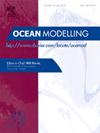Sediment dynamic responses to a severe typhoon in a stratified continental shelf sea
IF 2.9
3区 地球科学
Q2 METEOROLOGY & ATMOSPHERIC SCIENCES
引用次数: 0
Abstract
Under the background of global warming, an intensification of severe typhoons has been observed, with a notable trend of these typhoons shifting poleward and shoreward. This study employed a coupled hydrodynamic-sediment model to investigate the hydrodynamic and sediment dynamic responses in the Yellow Sea (YS) to a northward-moving Typhoon Bolaven. The research further elucidates the cross-front transport and underlying mechanisms triggered by the typhoon. The typhoon led substantial resuspension of seabed sediments and rapid changes in bed elevation, a consequence of the extreme waves generated by the typhoon. A cyclonic pattern was identified in both volume and sediment transport within the central and eastern YS. Significant fluctuations in volume and sediment transport were observed near the frontal zone in the western YS during the typhoon's influence. The critical period for cross-front transport was identified as the 24-hour period following the typhoon's passage. The net transport flux of sediment with high concentration from the Subei Coast to the central YS across the front was calculated to be approximately 0.03 Mt, spanning a transport distance of 2∼15 km. This cross-front transport was predominantly propelled by a cross-front flow, which was a result of the seaward barotropic pressure gradient force (PGF) due to the surge near the Subei Coast. The water temperature pattern during summer enlarged the difference of water level difference between the Subei Coast and the central YS, thereby reinforcing the barotropic PGF. This study offers profound insights into the sediment dynamic response to extreme events in a stratified continental shelf sea characterized by front systems.
层状大陆架海对强台风的泥沙动力响应
在全球变暖的背景下,强台风的强度有所增强,并有向极地和海岸移动的显著趋势。采用水动力-泥沙耦合模型,研究了台风“博拉文”对黄海水动力和泥沙的响应。研究进一步阐明了台风引发的锋间输送及其机制。台风导致海床沉积物的大量再悬浮和海床高度的快速变化,这是台风产生的极端波浪的结果。在赤道中部和东部的体积和泥沙输运中都发现了气旋模式。在台风影响期间,西赤道锋面附近的体积和输沙量有显著波动。横锋运输的关键期为台风通过后的24小时。计算结果表明,从苏北海岸沿锋面向西南中部输送高浓度泥沙的净通量约为0.03 Mt,输送距离为2 ~ 15 km。苏北沿岸风暴潮形成的向海正压梯度力(PGF)是此次横锋输送的主要动力。夏季水温格局扩大了苏北海岸与中部赤道的水位差,增强了正压PGF。该研究对以锋系为特征的分层大陆架海中极端事件的沉积动力学响应提供了深刻的见解。
本文章由计算机程序翻译,如有差异,请以英文原文为准。
求助全文
约1分钟内获得全文
求助全文
来源期刊

Ocean Modelling
地学-海洋学
CiteScore
5.50
自引率
9.40%
发文量
86
审稿时长
19.6 weeks
期刊介绍:
The main objective of Ocean Modelling is to provide rapid communication between those interested in ocean modelling, whether through direct observation, or through analytical, numerical or laboratory models, and including interactions between physical and biogeochemical or biological phenomena. Because of the intimate links between ocean and atmosphere, involvement of scientists interested in influences of either medium on the other is welcome. The journal has a wide scope and includes ocean-atmosphere interaction in various forms as well as pure ocean results. In addition to primary peer-reviewed papers, the journal provides review papers, preliminary communications, and discussions.
 求助内容:
求助内容: 应助结果提醒方式:
应助结果提醒方式:


